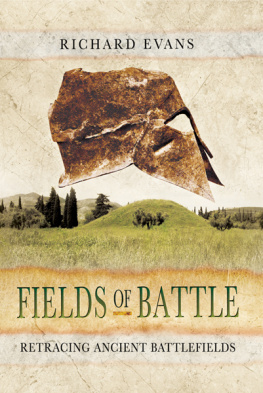First published in Great Britain in 2013 by
Pen & Sword Military
an imprint of
Pen & Sword Books Ltd
47 Church Street
Barnsley
South Yorkshire
S70 2AS
Copyright Richard Evans 2013
HARDBACK ISBN: 978 1 84884 797 2
PDF ISBN: 978 1 47383 105 6
EPUB ISBN: 978 1 47382 989 3
PRC ISBN: 978 1 47383 047 9
The right of Richard Evans to be identified as the Author of this
Work has been asserted by him in accordance with the Copyright,
Designs and Patents Act 1988.
A CIP catalogue record for this book is available from the British
Library
All rights reserved. No part of this book may be reproduced or
transmitted in any form or by any means, electronic or mechanical
including photocopying, recording or by any information storage and
retrieval system, without permission from the Publisher in writing.
Typeset in Ehrhardt by
Mac Style, Driffield, East Yorkshire
Printed and bound in the UK by CPI Group (UK) Ltd, Croydon,
CRO 4YY
Pen & Sword Books Ltd incorporates the imprints of Pen & Sword
Archaeology, Atlas, Aviation, Battleground, Discovery, Family
History, History, Maritime, Military, Naval, Politics, Railways,
Select, Social History, Transport, True Crime, and Claymore Press,
Frontline Books, Leo Cooper, Praetorian Press, Remember When,
Seaforth Publishing and Wharncliffe.
For a complete list of Pen & Sword titles please contact
PEN & SWORD BOOKS LIMITED
47 Church Street, Barnsley, South Yorkshire, S70 2AS, England
E-mail:
Website: www.pen-and-sword.co.uk
Contents
Acknowledgements
I t is appropriate that here that I should thank the Research Committee of the School of History, Archaeology and Religion (Chair: Professor Josef Lssl) at Cardiff University for providing funds that allowed me to visit some of the sites discussed in this volume, including Sybaris, Heracleia (Siris), Metapontum and Tarentum during the summer of 2012.
I should also like to note my continuing association with the Department of Classics and World Languages at the University of South Africa, Pretoria, in which I hold the honorary position of Academic Associate.
I should also like to extend a warm thanks to Dr Alun Williams (Cardiff) for his permission to reproduce here the picture of Lindos on Rhodes, and to Dr Lea Beness and Professor Tom Hillard of MacQuarrie University, NSW, for their permission to use their slides of Aquae Sextiae and the Fossae Marianae (Arles-Marseilles Canal).
Preface
I t is arguably insufficient to try and recreate the military events from ancient history by simply using the available, often fragmentary literary sources and therefore archaeological, and especially numismatic, evidence can be very helpful in trying to understand how episodes unfolded in the distant past. Better still should be the objective, not always fulfilled of course, to visit the relevant sites under discussion and to reach an interpretation of events through as detailed an analysis of the place through thorough empirical investigation. Therefore, the aim in this volume, and the one to follow, is as far as has been possible, to trace a number of scenes of battles by firstly looking at the minutiae of the subject and secondly by employing an on-the-site knowledge to obtain a clarity not hitherto achieved in such discussions; hence the title Retracing Ancient Battlefields.
In recent years, I have been fortunate enough to become reasonably well acquainted with the archaeological remains of Sybaris, Motya, Syracuse and the topographical features of numerous other former Greek and Roman cities and towns in Magna Graecia and Sicily, and what is even more important their geographical context. I have also been able to visit Arelate (Arles) and Aquae Sextiae (Aix-en-Provence) and parts of the Rhone valley and Delta, and also several of the main centres in north-eastern Spain (Catalonia) such as Emporion (LEscala), Barcino (Barcelona) and Tarraco (Tarragona). I regret that I have not yet been able to organize a visit to Alexandria, but have become familiar with the cities of ancient Asia, including Pergamum (Bergama), Ephesus, Miletus and Halicarnassus (Bodrum), which also feature in ) allowed me the opportunity to exploit my familiarity with the geography of South Africa and with its more recent history. In the process of the following discussion not only is the intention to throw some clarity on often misperceived events in the ancient world but also to debunk quite a few myths that have entered not only the ancient but also the modern literature.
Abbreviations and Notes
T he abbreviations employed in this work follow the standard and common practice and therefore should be readily understandable. While the ancient sources have been referenced to modern editions, the translations are mine and any errors that remain here are also mine alone.
I make no apology for the almost idiosyncratic use of Latinized names for some of the Greek characters and place names while employing a transliteration of the original Greek for others. However, all should be easily recognizable.
Maps and Plans
Chapter 1
Chapter 2
Chapter 3
Chapter 4
Chapter 5
List of Plates
(Except for number 4, for which see under the Acknowledgements, all others are the authors own)
Chapter 1
Chapter 2
Chapter 3
Chapter 4
Chapter 5
Chapter One
The End of Sybaris (510 BC)
I f you were to gaze out through the haze of a summers day from the Pollino Massif in that part of southern Italy, which is the border between Calabria and Basilicata, where the Tyrrhenian and Ionian Seas are separated by scarcely a hundred kilometres (60 miles) of mountainous terrain, you might find it difficult to grasp that two and a half thousand years ago there should have been visible below towards the east a thriving metropolis. H.V. Morton wrote, in one of his travels to Italy in the mid-1960s, that:
When I left Castrovillari I could look down over blue hills and woodland to the Ionian Sea and the yellow plain upon which the city of Sybaris once stood. Rich and famous, the parent of Paestum, a city that could put three hundred thousand men into the field, a city whose wealth and luxury excited the envy of the Hellenic world. Sybaris has vanished from the map.
This city is mentioned numerous times in the ancient literature and examples of its coinage illustrate apparently a sophisticated and wealthy community. It is a little more than thirty-four kilometres (21 miles) from the town of Castrovillari to the Museo di Sibaritide, which is situated on the edge of an area that has been identified, after prolonged excavation work, as the site of Thurii beneath which lay Sybaris. The landscape is a rather non-descript coastal plain of mostly cultivated fields criss-crossed by roads and irrigation ditches. The museum, a modern building of utilitarian design, constructed some years after Morton came here, is also about three kilometres ( of a mile) from the sea and the modern lidos that characterize the landscape of the Italian coastline. This countryside has that timeless quality that is quintessentially Mediterranean although, as is often the case, it hides well the fact that much has changed here since the ancient world, not least it seems the disappearance of so powerful a city of the Greeks. How and why did Sybaris cease to be and how much truth can we attach to the ancient accounts of its end? These questions and a search for answers are the focus of the discussion here in this first chapter of tracing ancient battlefields.
Not least among the intriguing aspects of this subject is the widely reported information that once the city of Sybaris had been occupied by its besiegers the Crotoniates they not only levelled the whole urban area to the ground but they then covered it with water. Indeed the geographer Strabo, writing in the first century AD, states (16.1.14) that the local river or rivers, the Crathis and the Sybaris, were diverted over the site so that its whereabouts would thereafter be completely forgotten. Yet it was not forgotten and in fact tales about Sybaris and its end seem to have quickly sprung up during or soon after the Classical period of Greece, initially perhaps within a generation or two of its apparent demise. The result was that the citys name became forever linked with wealth and unimaginable riches, and its citizens described as devotees of an unparalleled decadent lifestyle. However, scepticism has not surprisingly been voiced and here again it is well worth noting another comment by Morton.
Next page













